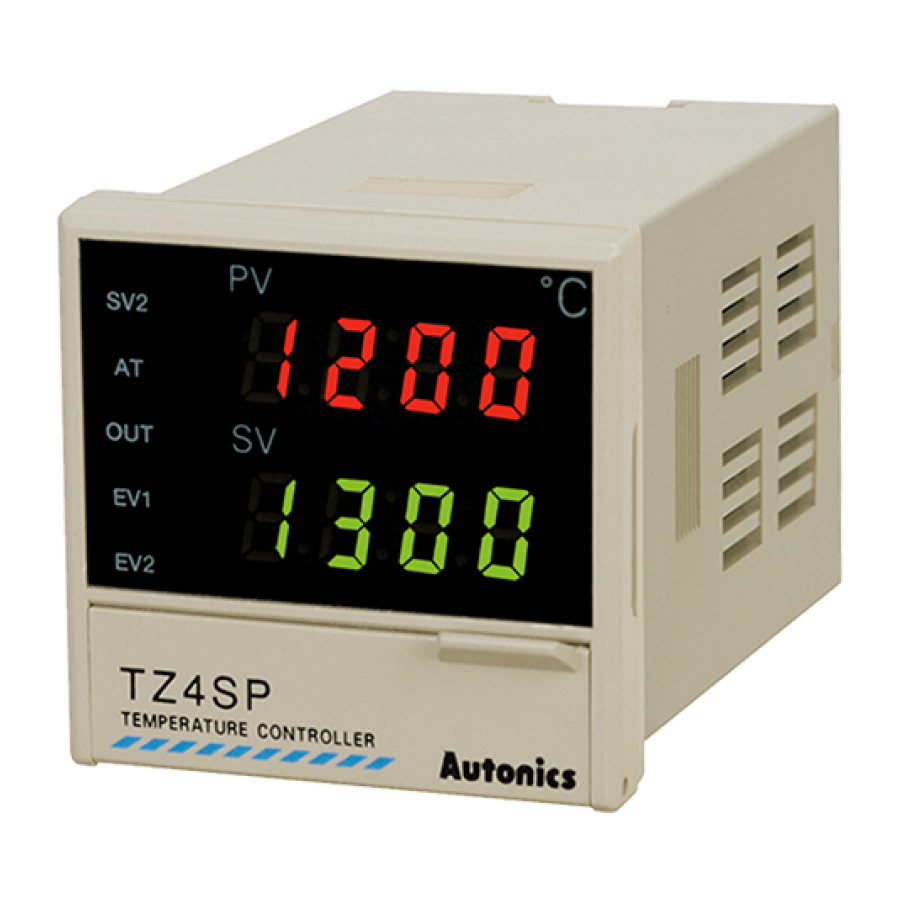Autonics TZN4M Manuel - Sayfa 12
Kontrolör Autonics TZN4M için çevrimiçi göz atın veya pdf Manuel indirin. Autonics TZN4M 17 sayfaları. Dual pid control temperature controller
Ayrıca Autonics TZN4M için: Manuel (4 sayfalar), Kullanım Kılavuzu (2 sayfalar), Manuel (16 sayfalar), Manuel (16 sayfalar), Manuel (17 sayfalar)

Factory Defaults
Parameter group 1
Parameter Default
Parameter Default
SU-2
0
P
AL1
10
I
AL2
10
D
LBA
600
T
AHYS
2
HYS
Functions
SV 2 temperature
You can control an additional temperature value at a desired
range by using SV2. Connect a contact signal (under 5VDC,
250㎂) at the external terminal, to operate in the range
where the signal turns ON. Set the SV2 temperature in SV2
temperature [SU-2] in parameter group 1.
Temperature
SV 2 [SU-2]
SV
External terminal
E.g.) The internal temperature of an electric oven may
drop rapidly if the door is opened while the oven
is maintaining a specific temperature. Set SV2
temperature [SU-2] to a higher value than SV, and
input a signal to the external terminal (SV2 IN), to
quickly raise the temperature.
Auto-tuning
Auto-tuning allows the temperature controller to detect the
thermal characteristics and response rates of the control
target. It then calculates the PID time constant and sets the
value to allow fast response rates and high accuracy. Hold
the
key for 3 sec during RUN mode to start auto-tuning.
The auto-tuning indicator will blink. When auto-tuning is
completed, the auto-tuning indicator will durn off and the
PID time constant will be saved to each parameter of
parameter group 1. The saved parameters can be adjusted
as desired.
Auto-tuning based on SV
TUN1
Temperature
mode
SV
[ TUN1 ]
Auto-tuning based on 70% of SV
Temperature
TUN2
SV
mode
[ TUN2 ]
70%
To manually stop auto-tuning, hold the
When auto-tuning is stopped, the controller maintains the
PID value before auto-tuning. TZ Series supports 2 auto-
tuning modes.
Select TUN1 mode or TUN2 mode [TUN1, TUN2] from
auto-tuning mode [AtT] of parameter group 2.
※ Run auto-tuning during initial setup of the temperature
controller.
※ If the thermal characteristics of the control target device
has changed after extended usage, re-run auto-tuning.
Parameter Default
#0
IN-B
0
0
REST
)0
0
RAPU
10
20
RAPD
10
2
LOC
OFF
(SV2 IN)
Time
ON
Auto-tuning
Time
Auto-tuning
Time
key for 5 sec.
Dual PID Control
Parameter group 2
Parameter Default
Parameter Default
IN-T
KCaH
O-FT
EU-1
AL-1
UNIT
EU-2
AL-2
H-SC
AL-T
AL-A
L-SC
AtT
TVN1
DOT
PIDT
PIdS
FS-H
Ramp
The ramp function can delay the rate of temperature rise/
fall. If the SV value is changed during stabilized control, the
temperature of the controlled target will rise/fall during ramp
up/down time [RAPU, RAPD] of parameter group 1. The
ramp function activates when the power is reset or when
the SV value is changed during stable control.
※ The ramp up/down time [RAPU, RAPD] appear only when
the ramp function [RAMP] of parameter group 2 is set to
ON.
●RAMP up time[ RAPU ]
When delaying the rise of initial control temperature or
changing the SV during stable control, you can delay
temperature rise. Set the ramp up time [RAPU] longer than
the temperature rise time (tu) when not using the ramp
function.
Temperature
Changed SV
Initial SV
tu
Ramp up time
[ RAPU ]
●Ramp down time [RAPD]
Delays declining temperature. Set the ramp down time
[RAPD] longer than the temperature decline time (td) when
not using the ramp function.
Temperature
Changed SV
Initial SV
Parameter Default
HEAT
FS-L
`00
?C
RAMP
OFF
1300
BPS
2400
`00
ADRS
01
0
LOC
OFF
1300
: Not using ramp function
: Using ramp function
Time
tu
Ramp up time
[ RAPU ]
: Not using ramp function
: Using ramp function
Time
td
Ramp down time
[ RAPD ]
J-151
SENSORS
CONTROLLERS
MOTION DEVICES
SOFTWARE
(J)
Temperature
Controllers
(K)
SSRs
(L)
Power
Controllers
(M)
Counters
(N)
Timers
(O)
Digital
Panel Meters
(P)
Indicators
(Q)
Converters
(R)
Digital
Display Units
(S)
Sensor
Controllers
(T)
Switching
Mode Power
Supplies
(U)
Recorders
(V)
HMIs
(W)
Panel PC
(X)
Field Network
Devices
